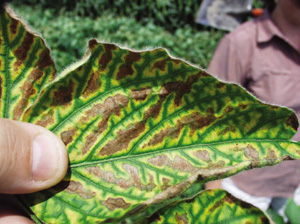
Features
Agronomy
Other Crops
Exploring the possibility of mung bean production
Anyone who eats Chinese food is familiar with the bean sprouts used in dishes like chop suey. Those sprouts are from mung bean, and they are eaten by millions of people around the world.
November 6, 2008 By Carolyn King
Can the bean of Chinese cuisine be grown in Western Canada?
 |
| About 30 of the 206 mung bean lines appear to have good adaptability and physiological maturity that meets growing season requirements in southern Alberta. Photos courtesy of Mark Olson, Alberta Agriculture and Rural Development. |
Anyone who eats Chinese food is familiar with the bean sprouts used in dishes like chop suey. Those sprouts are from mung bean, and they are eaten by millions of people around the world. And that is a big market. Could Canadian growers successfully produce mung bean here? Alberta researchers are taking the first steps to answer that tantalizing question.
“There’s a huge opportunity if we could grow mung bean. When you talk to Chinese people about mung bean, or what they call green bean, their faces light up. They’ll tell you that mung bean soup cools you in the summer and warms you in the winter. They believe mung bean has some medicinal qualities. They love the ‘glass’ or vermicelli noodles and moon cakes, which are made from mung bean starch,” says Mark Olson, the provincial pulse industry development specialist with Alberta Agriculture and Rural Development. “When I was in China in 2005, my hotel had a free giveaway during the autumn festival for moon cakes, and I had to work my way through all these people lined up around the block for
moon cakes.”
Olson is leading the Alberta mung bean project, which is funded by the Alberta Crop Industry Development Fund. In Phase 1 of the project, a consultant evaluated various potential pulse crops like purple bean, lima bean, cowpea, winged bean, black gram and mung bean to determine whether they might make economic sense for Alberta production. Mung bean came out at the top of the heap, because of its large, stable and relatively high-value market.
In Phase 2, which started in 2005, a team of researchers is exploring the production and market potential of Alberta-grown mung bean. The other members of the team are: Dr. Deng-Jin Bing from Agriculture and Agri-Food Canada; Dr. Manjula Bandara, Art Kruger and Boris Henriquez from Alberta Agriculture and Rural Development; and Cheryl Davie, a market researcher. The researchers are also collaborating with Professor Tian from the Hebei Academy of Agriculture and Forestry Sciences; she is a Chinese research scientist who has been working with mung bean for more than 20 years.
A first look at the agronomics
In fall 2005, Olson and Bing went to China to look at mung bean production and obtained 20 lines directly from Tian. In co-operation with Dr. Axel Diederichsen of Plant Gene Resources of Canada, the researchers also brought in small amounts of seed from gene banks all over the world, totalling some 206 mung bean lines. The researchers multiplied the seeds in Alberta greenhouses and then conducted field plot trials in 2006, 2007 and 2008.
“I set the greenhouses for 12 hours of day and 12 hours of night to make sure all the lines flowered and set pod. Then we collected seed off of the plants,” explains Olson. Mung bean is grown mainly in tropical and subtropical regions of Asia, so many of the lines came from areas that do not experience the great changes in day length that are common during the growing season in western Canada. Olson notes that mung beans come in two basic types: Vigna radiata, which is called green gram or green bean in China, and Vigna mungo, which is called black gram or urid bean. “The Japanese are very interested in the black types. Unfortunately we didn’t get many of the black types, and none of them were day-neutral. Although we got phenomenal yields in the greenhouse – I counted 80 or 90 pods on some of the plants – when we took them out to the field they didn’t even flower because of our increasing and decreasing day length. So none of the black lines were suitable for Alberta.”
The plot trials were conducted in Lethbridge and Bow Island in 2006, in Bow Island and Brooks in 2007 and in Brooks in 2008. “We decided to go to the places that made the most sense first,” says Olson. “Anything in the bean family will perish if it gets even a degree or two of frost, and if it’s going to be a high value crop, we would want to irrigate it. So we went to southern Alberta. Eventually if it looks like mung bean is going to do well and if the market is there, then maybe we can look at growing it outside of that area.”
Based on the 2006 plot trials, about 30 of the green gram lines appear to have good adaptability and physiological maturity that meets growing season requirements in southern Alberta. In 2007 and 2008, those 30 lines were further assessed for physiological maturity, yield and seed quality. Olson says, “Out of those 30, there are six that I think really have some good potential.”
From the plot results, Olson guesses that typical yields might possibly be in the range of 500 to 1500 lb/acre, but it’s too early to predict exactly how well the crop might perform. In 2007, the highest yielding line produced about 1200 kg/ha in the small plots.
One important concern has appeared in the trials. Olson says, “We have found that mung bean is very susceptible to common bacterial blight. It’s a difficult disease in that whole bean family, so we’re facing a challenge there.”
 |
 |
 |
| Flowering stage of mung bean | Mung bean seed | Mung bean seems to start slowly at the start of the growing season. |
Assessing market potential
The project’s other component, being conducted by Cheryl Davie, is to see whether it would make economic sense to grow mung bean in Alberta. Olson outlines the current market situation. “In 2007 Canada imported 4078 tonnes of mung bean; that’s about nine million pounds or roughly 150,000 bushels. So if we could produce 1000 lb/acre, we’d have potential for something like 9000 to 10,000 acres to displace the imports. And if we have the right quality, we could potentially export as well.”
A key part of Davie’s in-depth marketing study is to talk with the people who currently import mung bean, including businesses that sprout the beans, and businesses that clean and bag them. She is asking about such aspects as their requirements for bean quality, whether they might be willing to buy Alberta mung beans, what they would be willing to pay, and whether they would be willing do an evaluation of the Alberta product when sufficient seed becomes available.
Her findings so far have been quite positive. The buyers are interested in an Alberta product, and the Alberta samples compare well with mung bean samples from other sources, based on the buyers’ initial visual inspection. She is also finding that buyer requirements for bean quality vary. For instance, the sprouters are looking for high germination and a bright white colour for the sprout, while some other buyers want large seeds with a bright green colour.
Next steps
Phase 2 of the project wraps up in fall 2008. Whether the project has a Phase 3 will depend on the Phase 2 results and the availability of funding. Olson says, “By November we should have some pretty solid conclusions, and then we have to decide what’s the next step. For instance, do we need to do breeding work or do we simply take the six best lines and start multiplying them out?”
Dr. Parthiba Balasubramanian, a bean breeder with Agriculture and Agri-Food Canada who has worked with mung bean, has looked at samples from the Alberta plots. According to Olson, Balasubramanian sees some good potential in the plots he visited and would be interested in doing breeding work to improve them, if funds become available. Along with breeding, Phase 3 would also likely involve looking for a commercial interest to become involved in the initiative.
Could it pay to grow mung bean under irrigation in the bean-growing areas of Alberta? Olson says, “I’m cautiously optimistic. Mung bean is a weakly competitive crop, it does seem to need the heat, and it seems to grow really slowly in the beginning. There’s a lot of work to be done before it’s a commercial crop.”